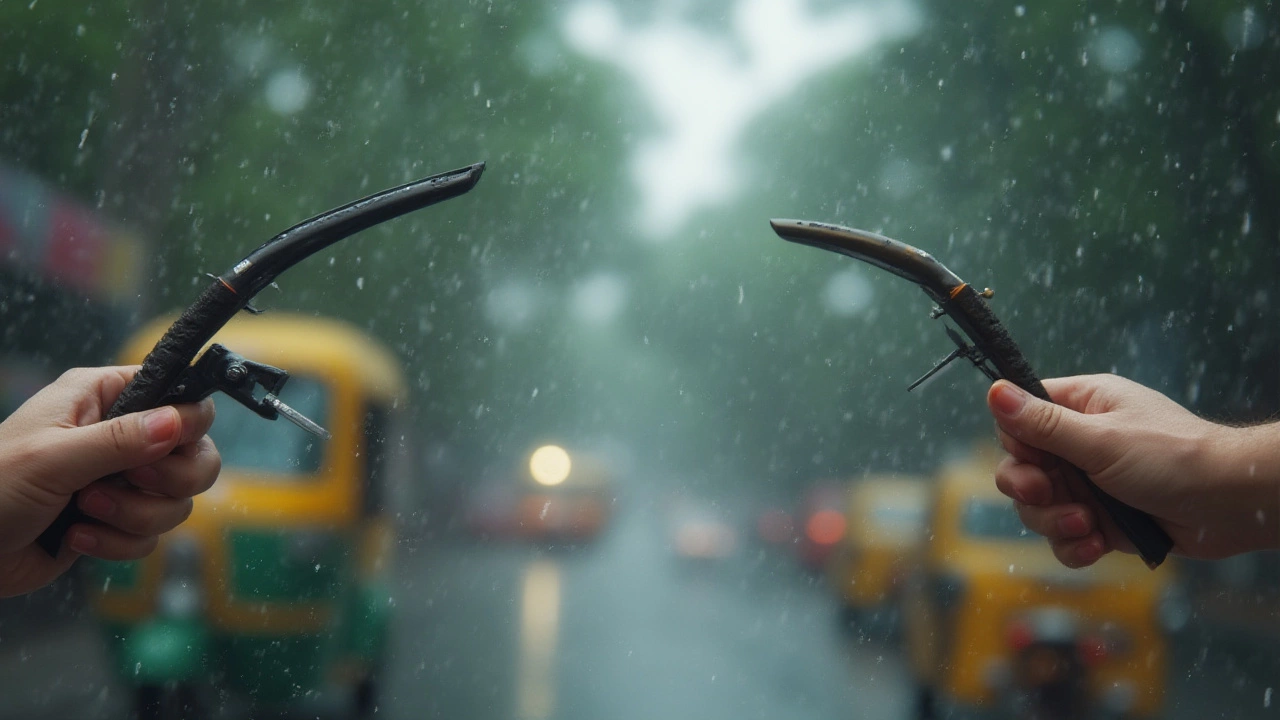Ever been caught in those sideways Adelaide rainstorms, wipers going flat-out, only to realize you can barely see? I’ve been there, white-knuckling the steering wheel while Finneas laughs at the back, not knowing Dad might as well be wearing a blindfold. The truth is, not all wipers are created equal—even if they look similar at first glance. Folks debate which is best at the hardware store or dealership parts counter, but the heart of it really comes down to just two main types of windshield wipers. And yes, that difference can mean the difference between crisp, streak-free visibility and that annoying oily blur you wind up wiping with your sleeve later.
The Two Main Types of Windshield Wipers: Breaking Down the Basics
The world of wiper blades is basically a two-horse race: conventional (sometimes called bracket or frame-style) and beam wipers. Each has its own design, strengths, and potential headaches. Conventional wipers, the kind wedged onto Aussie cars for decades, use a metal or plastic framework with several pressure points that hold a strip of rubber against the glass. You’ll spot these by the visible skeleton of arms and joints that curve with the blade.
Beam wipers, on the other hand, cut a much sleeker figure. There’s no exposed frame—just a solid, curved strip. The magic? The blade is molded to hug the windscreen evenly, flexing from end to end. Beam blades first made headlines on high-end European cars, but now you’ll find them as stock equipment on plenty of Toyotas, Hyundais, and Fords Down Under.
It’s not just car manufacturers that have hopped on the beam-blade bandwagon. The big auto parts chains have entire walls plastered with beam and conventional options, all promising better wipe patterns or longer life. If you’ve ever stood squinting at a wall of blades, trying to decode “hybrid,” “premium,” or “aero-dynamic,” you’re not alone. At the core, it’s all about how the blade presses rubber against glass in the wet, the cold, or even that dusty haze we get when local farmers start plowing.
Interestingly, the actual materials under the hood (well, on the windscreen) haven’t changed as radically. Both types rely on rubber-to-glass contact, though some beam wipers now use rubber blends designed for chemical resistance or to stay flexible at low temperatures—which by South Australia standards, isn’t exactly Arctic, but try explaining that to your pre-dawn commute in June.
If you want the nerdy details, here’s a quick comparison in table form:
| Type | Frame | Flexibility | Wind Performance | Cost (avg AUD) | Best For |
|---|---|---|---|---|---|
| Conventional | Exposed Metal/Plastic | Moderate | Average | $10-25 | Older Cars, Tight Budgets |
| Beam | One-piece Rubber/Plastic | High | Excellent | $28-45 | Modern Cars, High Speeds |
No matter which type you end up with on your windscreen, the check is the same: can you see clearly when it matters most? If not, your choice of wiper might be to blame.
What Makes Beam Wipers Different (And Why It Matters)
Here’s something that doesn’t make it into most sales pitches: beam wipers genuinely outperform conventional ones in certain Aussie conditions, especially on the newer, curved windscreens of most post-2010 vehicles. Their flat, continuous design mean they flex perfectly against glass that’s shaped like a bent cricket bat, not just a flat pane.
The real beauty of beam wipers is their pressure distribution. With no joints or exposed metal frame, force is spread evenly right along the blade, so you’re less likely to get those classic streaks on each side where a frame wiper’s elbows lift off at high speeds. If you drive on highways or take frequent road trips where wind is a factor, those old clattering conventional blades can start to flap and chatter way before a beam blade does.
Let’s get practical: beam blades are champions for winter, too. While our frost in Adelaide is nothing compared to Canberra’s deep-freeze, it’s not unusual to wake up to a surprise layer of ice or that clingy combination of dew and dust. Traditional frame wipers have a bad habit of those little frozen joints jamming up—suddenly only half your blade is actually touching the glass. Beam blades don’t have spots for water or grime to gather, so you get a consistent wipe—even if you’ve got a pile of morning frost or that weirdo dew only Australia seems to gift us at 6am.
If you like a low-maintenance car (who doesn’t?), beam wipers tend to age better, too. No little clips rusting away, no metal joints squeaking or breaking when you least expect it. That’s especially clutch if your vehicle spends a lot of time parked under the hot, dry sun or gets left near the salty air by the coast.
One last bit: beam blades tend to look neater, sitting flush with the windscreen. Not something you probably thought about until you try swapping out a clunky old frame blade with a low-profile, blacked-out beam blade—makes the whole car seem tidier, kind of like switching from those giant brick phones to slick smartphones. Modern windscreens are often specifically designed for this type of blade, so it’s worth checking your manual or giving the replacement guide at Repco or Supercheap Auto a skim before you head to the check-out.

The Case for Conventional Wipers: Tradition Isn’t Dead Yet
With all this talk about shiny new beam technology, you might think frame-style wipers are ready for the museum. Not so fast. Conventional wipers won’t disappear any time soon, and plenty of drivers stick with them for solid reasons. First: cost. If your budget is tight or you’re running an older Commodore that doesn’t see much wet-action, a pair of regular bracket wipers does the job at half the price of beams—sometimes less if you time your run for a sale or shop at the right indie parts dealer.
There’s something to be said for how easy they are to swap, too. Anyone who’s tried to fit a fancy beam blade in a carport in the dark can tell you: nothing beats the old-school ‘hook and snap’ frame design. The universal fit means you’re almost never stuck with a blade you can’t use, and even my Finneas can figure it out after seeing it once (kids today pick up this stuff fast, honestly).
Maintenance is simple, too. If the rubber splits or streaks, you can sometimes get replacement inserts for just a few bucks without touching the frame at all. Sure, they might emit a bit of chatter on really bent or heavily curved windscreens, but if your car’s an older model with a mostly flat windscreen, conventional is perfectly adequate. Classic car owners, you know the drill.
One often missed perk: in outback or rural driving where mud, dust, or bugs are constant, some folks prefer a stronger frame they can remove and clean out thoroughly—or even bend back into shape after a big chunk of country debris. Beams, being all-in-one, can’t be fixed the same way. Throw in the fact that you’ll find replacement conventional blades at every servo between here and Alice Springs, and it’s no wonder they’re not extinct.
Think about the way you use your wipers. Maybe you’re not dealing with wild, mixed weather or don’t need that ultra-hugging fit to the screen. Sometimes simple works better, especially for vehicles that clock most of their time parked in the shed rather than braving highways at 110km/h with a wall of rain in your face.
Choosing the Right Wipers for Your Car: Tips from the Real World
Sure, the technical stuff matters, but picking the right wipers comes down to matching your driving style, your car’s age, and where you live. Adelaide drivers, for example, get the whole spectrum: rain, sun, beach mist, even bushfire smoke. Here’s what’s worked for me—and for plenty of drivers I know.
- Windshield wipers should always match your existing mounting style. Double-check your manual or pull the old blade and take a photo on your phone before heading to buy replacements.
- For most modern cars, especially after 2010, beam blades are the better fit. You’ll get a cleaner wipe, less vibration, and they last longer in mixed weather.
- If you’re looking to save cash or have a classic car with mostly flat glass, stick with conventional blades—but check for rubber wear every six months.
- Brand does matter. Stick with a name you recognize—Bosch, Trico, Valeo, or any of the big players. No-name blades often miss the mark on fit or quality.
- If you notice streaks, squeaks, or hear that telltale chugga-chugga noise, it’s time for new blades. Most Aussie drivers swap them yearly; more often if you do lots of highway runs or park outside.
- Cleaning matters: every so often, wipe your blades down with a soft cloth and washer fluid. Dust and sap shorten the life of any wiper, no matter the type.
Here’s an oddity I learned the hard way: some newer cars use a unique attachment system at the wiper arm. These are almost always factory-fitted with beam blades. Don’t force a conventional blade onto these arms—you’ll end up with an uneven wipe or risk the blade flying off mid-drive. If in doubt, snap a quick photo of the wiper connection and show it at the parts store.
For those dealing with Adelaide’s infamous summer storms, look for blades advertised as high-performance or all-weather. These usually have better rubber compounds and UV resistance, perfect for cars that cook all day in the track-side parking at the Adelaide 500.
Are hybrid wipers a thing? Yes, and they’re popping up more often. “Hybrid” just means a conventional frame covered with a partial aerodynamic shroud to reduce wind-lift, which is a sort of best-of-both-worlds solution. That said, they’re not as common, and prices float near the beam-blade range.
Don’t be afraid to test a few brands and see what lasts on your car. I’ve had Trico Edge beams survive two full, harsh Adelaide summers, while some unknown-brand frame blades lasted only four months. Pay a bit more upfront, save frustration during the next wild downpour.




